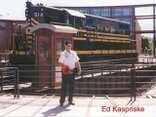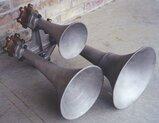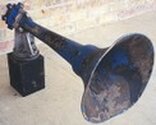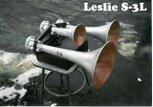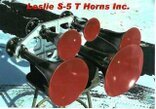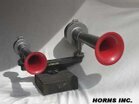Leslie Controls |
1 | Leslie A-200 | This is the sequel to our most popular video ever. Watch the action on this 12 miles, 2% grade, pusher district between Crawford and Belmont, Nebraska. Burlington Northern in Cascade Green, Kansas City Southern, Union Pacific, and Santa Fe all make appearances. On-screen graphis indicate locations and train information. Not narrated. One hour, color and sound. | |
2 | Leslie A-200 | A Leslie A-200 in service | |
3 | Leslie A-200 | A PRR. GG-1 blowing by with its Leslie A-200 sounding | |
4 | Leslie A-200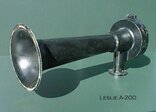 | The Leslie Tyfon A-200 was one of the most popular horns of early dieselization, showing up on hundreds of EMD passenger and freight locomotives, as well as Pennsylvania Railroad's GG1 electrics, and even some late steam locomotives such as Southern Pacific's famous semi-streamlined Daylight 4-8-4's such as #4449.
Factory tuning was: D#
Once very popular, the single chime "honkers" like the A-200 fell out of favor with the advent of the multi-chime airhorn. Rare to find today, the A-200 can still occasionally be heard on older shortline locomotives and on museum engines.
Airhorn from A-200 sound samples: Sample1 | |
5 | Leslie A-200 | A-200 sound samples:
Sample2 | |
6 | Leslie A-200 | A-200 sound samples:
Sample3 | |
7 | Leslie A-200 | A-200 sound samples:
Western Pacific F-units, courtesy Dan Furtado:
Sample4 | |
8 | Leslie RS-3L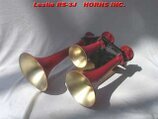 | This RS-3L was modified by sectioning down the #25 bell to 19and a half inches to sound C. The #31 bell was sectioned down to 16 inches to sound D#, and the #44 bell has spacer pitch ring added to sound G#. Final chord: C, D#, G#. | |
9 | Leslie RS-3B | A very interesting sounding horn, to say the least, and certainly not very common. | |
10 | Leslie S-3B | An S3B on a J manifold. This type of horn was occasionally heard on the L&N | |
11 | Leslie S-3B | The S3B and the S3E below are very unusual sounding horns. | |
12 | Leslie S-3JB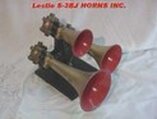 | Leslie S-3bj This is a rarely used application of Leslie, I remember seeing some on PRR. General Electric U series diesel's of the 1960's. sounding the chord of F#, A, C#. A high pitched minor triad. Some used the now obsolete "J" manifold, such as this one, also the diaphragm housings and back caps on this one are brass. | |
13 | Leslie S-3BJ | My Leslie S-3bj on Sherry's Durango up at Abbel Farm Rd. Little, Meadows, Pa. | |
14 | Leslie S-5D | The S-5D was Leslie's first five-chime Supertyfon airhorn. Produced only in 1952, it played the same notes as the Nathan M5. Two different manifold designs were used on the S-5D. The one shown in the photo is the later version, with diagonal and horizontal bracing around the two highest bells (the 554 and 440). Earlier S-5D manifolds lacked these extra pieces, with the bells mounted precariously on "stalks" similar to the high profile J-base used on the S-3J. Only a few S-5D's were produced before Leslie introduced its replacement, the S-5T, in 1953. Factory tuning was: A major dominant 7th (C#,E,G,A,C#).
The horn used Supertyfon bells #277, 330, 392, 440, and 554. The numbers refer to the bells' resonant frequencies in hertz. In later Leslie production, bell numbers were truncated to just the first two digits.
A few S-5D's survive today in private collections.
Airhorn: Sample1 | |
15 | Leslie S-3J | An old recording of a Leslie S3J on a Penn Central freight. Very similar to the Nathan P-3. | |
16 | Leslie S-3J | Horn and photo courtesy Brent Lee. One of the bells could also be reversed to provide good sound volume in both directions. Note the two-piece #277 bell and the bronze power chambers, common only to early Supertyfon production.
Factory tuning: A major triad (C#, E, A).
The horn used Supertyfon bells #277, 330, and 440. The numbers refer to the bells' resonant frequencies in hertz. In later Leslie production, bell numbers were truncated to just the first two digits.
Though produced for less than a year, the S-3J found application on several railroads. The L&N, Illinois Central, Frisco, Rutland, and the Vermont Railway are believed to have purchased the horn before production ceased. None are known to still be in use today.
Airhorn from S-3J sound samples (courtesy Brent Lee): Sample1 | |
17 | Leslie S-3J | S-3J sound samples (courtesy Brent Lee):
Sample2 | |
18 | Leslie S-25 | Most of the bells used in multichime Leslie Supertyfon horns could also be purchased individually as single note horns. The Leslie S-25, for example, is simply the Supertyfon #25 bell on a base. The #25 is also the largest bell on the S-3L and S-5T. The picture shows a very early S-25, with a bronze power chamber and two-piece bell.
Factory tuning is: B
The S-25 was sometimes used on switcher locomotives, or on road units as an alternative to the A-200. The horn isn't common today, but can still be found on some switchers and industrial locomotives.
Airhorn from S-25 sound samples: Sample1 | |
19 | Leslie S-2B | Horn and photo courtesy Brent Lee. One of the bells could be reversed to provide good sound volume in both directions. The horn shown is an early version (1950's) with a two-piece #31 bell and bronze power chambers.
The S-2B was a less popular Leslie two-chime horn compared to the S-2M. It used the #31 and 37 bells, which are also the two lowest notes in the reasonably popular three-chime S-3K.
Factory tuning: The #31 bell plays D#, and the #37 plays F#.
The S-2B was not a very common horn despite its pleasing minor 3rd interval. It was presumably used by some railroads in lieu of the S-2M, but such uses have not been documented.
Airhorn from S-2B sound sample (courtesy Brent Lee): Sample1 | |
20 | Leslie S-2M | Leslie produces several two-chime Supertyfon horns, with the S-2M being the most popular. The horn uses the #31 and 44 bells, which are also the two highest notes in the ubiquitous S-3L three-chime horn. As with other Supertyfons, the use of the newer, spiked RS power chambers adds an "R" to the designation, yielding an RS-2M. When used on freight locomotives or switchers, the horn generally has one bell facing in each direction.
The all-bells-forward version of the S-2M is generally seen when the horn is used on passenger equipment. This Metra cab car has a guard around its horn, possibly to keep it from being damaged by a mechanical washrack or other low obstructions. The horn also has "shower caps" over the mouths of the bells to keep insects and foreign matter out.
Factory tuning: The #31 bell plays D#, and the #44 plays A.
The S-2M was reportedly used on New York Central E-units, and many Metra cab cars have all-bells-forward S-2M's. The horn can also be found on some older end-cab switchers. An S-3L whose #25 bell has gone silent will also sound like an S-2M!
Airhorn from S-2M sound samples: Sample1 (sehr kurz) | |
21 | Leslie S-2M | S-2M sound samples:
Sample2 (sehr kurz) | |
22 | Leslie S-3K | The S-3K is generally similar in appearance to the S-3L, and the same prefixes and suffixes apply to its designation. The horn was introduced to comply with a Canadian Board of Transport Ministers regulation requiring the use of the D# minor chord on railroad airhorns. Ironically, few were sold in Canada, but a number appeared in the US, particularly on early GE locomotives.
Prime Manufacturing Corp. of Oak Creek, WI produced a horn identical to the S-3K, which they called the PM-990.
Factory tuning is: D# minor (D#,F#,A#)
The horn uses the Leslie #31, 37, and 48 bells.
No large railroads have acquired the S-3K in recent years, but a few can still be heard on older BNSF locomotives of Burlington Northern ancestry.
Airhorn from Burlington Northern, various locomotives: Sample1 | |
23 | Leslie S-3K | Burlington Northern, various locomotives:
Sample2 | |
24 | Leslie S-3K | Burlington Northern, various locomotives:
Sample3 | |
25 | Leslie S-3K | Burlington Northern, various locomotives:
Sample4 | |
26 | Leslie S-3K | Burlington Northern, various locomotives:
Sample5 | |
27 | Leslie S-3K | Burlington Northern, various locomotives:
Sample6 | |
28 | Leslie S-3K | Burlington Northern, various locomotives:
Sample7 | |
29 | Leslie S-3K | Burlington Northern, various locomotives:
Sample8 | |
30 | Leslie S-3K | Burlington Northern, various locomotives:
Sample29 | |
31 | Leslie S-3K | When bad things happen to good horns
Like its more common cousin the S-3L, the S-3K shares the Supertyfon family propensity for harmonic overblowing and generally getting into trouble. Below are a few examples of S-3K's with various problems on Burlington Northern locomotives. Several bells fouled: Sample1 | |
32 | Leslie S-3K | Several bells fouled:
Sample2 | |
33 | Leslie S-3L | The Leslie S-3L once was the most common horn in North America. The chord, B, D#, A. while not too pretty, got the job done as well as being a familiar sound on most railroad's in the United States. | |
34 | Leslie S-3L | S-3L is a shorthand designation for any Leslie 3-chime Supertyfon horn that uses the #25, 31, and 44 bells (the "L" chord). The actual model designation of a given horn will have additional prefixes and suffixes as follows.
Prefixes:
R=improved horn bells with spiked back caps
L=low profile manifold
U=very low profile "universal" manifold.
Suffixes:
O=normal arrangement of bells from left to right is switched
F=full openings in orifice dowel pins (0.125 inch)
J=very narrow, tall manifold
R=one or more bells reversed (turned backward)
The designations can get quite complicated, and for the sake of simplicity, any S-3L with reversed bells is generally referred to as an S-3L-R. The horn pictured is an S-3L-RO, with the #25 bell on the left and the #31 on the right (standard arrangement is the other way around) and the #44 bell reversed. Other variations of the S-3L are shown below; click the thumbnail for a larger image:
The S-3L was introduced in the early 1950's as competition for the Nathan M-3. It rapidly became one of the most popular 3-chime airhorns ever produced. The S-3L was used extensively by Santa Fe, Union Pacific, Milwaukee Road, Soo Line, Missouri-Kansas-Texas (MKT), Chicago & Northwestern, Kansas City Southern, Erie Lackawanna, Reading, and many others.
Prime Manufacturing Corp. of Oak Creek, WI produced a horn identical to the S-3L, which they called the PM-920.
Factory tuning is: B inverted 7th (B,D#,A)
The S-3L was one of the most common multichime airhorns used by US railroads. In recent years, most of the large roads that used the S-3L have turned to Nathan horns instead. The horn remains in decreasing numbers on BNSF and former Conrail locomotives, as well as on regionals and shortlines nationwide.
Airhorn from Brent Lee's early S-3L: Sample1 | |
35 | Leslie S-3L | Santa Fe, various locomotives:
Sample2 | |
36 | Leslie S-3L | Santa Fe, various locomotives:
Sample3 | |
37 | Leslie S-3L | Santa Fe, various locomotives:
Sample4 | |
38 | Leslie S-3L | Santa Fe, various locomotives:
Sample5 | |
39 | Leslie S-3L | Santa Fe, various locomotives:
Sample6 | |
40 | Leslie S-3L | Conrail, various locomotives:
Sample1 | |
41 | Leslie S-3L | Conrail, various locomotives:
Sample2 | |
42 | Leslie S-3L | Union Pacific, various locomotives:
Sample1 | |
43 | Leslie S-3L | Union Pacific, various locomotives:
Sample2 | |
44 | Leslie S-3L | When bad things happen to good horns
Early Supertyfons tended to get fouled easily by dirty/oily supply air or from foreign matter entering the horn. This caused bells to go silent or harmonically overblow (squeal). The RS modifications mentioned above helped to an extent, but squealing Leslies can still be found, particularly when the horns have the largest available orifices. With the advent of the North American safety cab and its button-actuated solenoid horn valve, the horn is instantly subjected to the full force of the air blast, resulting in greater wear and a tendency for bells to sound poorly or quit sounding altogether. Below are a few examples of S-3L's in various states of deterioration.
Horns with one bell not sounding: Sample1 | |
45 | Leslie S-3L | Horns with one bell not sounding:
Sample2 | |
46 | Leslie S-3L | Horns with one bell not sounding:
Sample3 | |
47 | Leslie S-3L | Horns with one bell not sounding:
Sample4 | |
48 | Leslie S-3L | Horns with one bell not sounding:
Sample5 | |
49 | Leslie S-3L | Horns with one bell not sounding:
Sample6 | |
50 | Leslie S-3L | Horns with two bells not sounding:
Sample1 | |
51 | Leslie S-3L | Horns with two bells not sounding:
Sample2 | |
52 | Leslie S-3L | Horns with two bells not sounding:
Sample3 | |
53 | Leslie S-3L | Horns with two bells not sounding:
Sample4 | |
54 | Leslie S-3L | Horns with squealing bells:
Sample1 | |
55 | Leslie S-3L | Horns with squealing bells:
Sample2 | |
56 | Leslie S-3L | Horns with squealing bells and other problems:
Sample1 | |
57 | Leslie S-3L | Horns with squealing bells and other problems:
Sample2 | |
58 | Leslie S-3L | Horns with squealing bells and other problems:
Sample3 | |
59 | Leslie S-3L | Horn in just a world of trouble:
Sample1 | |
60 | Leslie S-3L | A standard S3L on a Norfolk Southern freight | 
|
61 | Leslie S-3L | You just don't hear horns like this on railroads today. | 
|
62 | Leslie S-3L | A Leslie S3K on the P&LE on June 19, 2004. | |
63 | Leslie S-3L | A Leslie S3K in active service, CSX | |
64 | Leslie S-3L | A Leslie S3K in active service, on a GP-10 locomotive | |
65 | Leslie RS3K | A static Leslie RS3K with echos. These horns were common on the Burlington Northern. | |
66 | Leslie SL-4T | These are less common then the Nathan H Series. Used on Amtrak until scrapped in 1977. Very few were salvaged. | |
67 | Leslie SL-4T | The SL-4T was developed in 1973 for Amtrak and was used exclusively on their first new locomotives, the SDP40F's. The horn used the same three bells as the S-3K plus the #55 bell. The chord was suggested by Deane Ellsworth, who was working for Chessie System at the time but would soon move to Amtrak and spearhead the development of other airhorns for the passenger carrier.
Factory tuning is: D# minor 7th (D#,F#,A#,C#)
The horn uses the Leslie #31, 37, 48, and 55 bells.
The SL-4T/S-4T was one of the shortest-lived horns ever produced in quantity. Within two years of its introduction, it had been supplanted by the Nathan P5a as Amtrak's standard horn (the P5a in turn would be replaced by the K5LA a few years later). Even then, some SL-4T's might have persisted on Amtrak for a decade or more had it not been for the poor fortune of the locomotives on which they were mounted. A series of derailments blamed on the SDP40F's led Amtrak to phase the big units out of service by the early 1980's. A few horns were swapped around onto other Amtrak units, but in general the SL-4T's were retired along with the SDP40F's. As a result, the horn is essentially extinct in railroad use today.
Airhorn from Amtrak SDP40F (courtesy Dave Decker): Sample1 | |
68 | Leslie SL-4T | Amtrak SDP40F (courtesy Dave Decker):
Sample2 | |
69 | Leslie SL-4T | Amtrak SDP40F (courtesy Dave Decker):
Sample3 | |
70 | Leslie SL-4T | Amtrak SDP40F (courtesy Dave Decker):
Sample4 | |
71 | Leslie SL-4T | Amtrak SDP40F (courtesy Dave Decker):
Sample5 | |
72 | Leslie SL-4T | Dave Decker's SL-4T:
Sample1 | |
73 | Leslie SL-4T | Dave Decker's SL-4T:
Sample2 | |
74 | Leslie SL-4T | Dave Decker's SL-4T:
Sample3 | |
75 | Leslie SL-4T | Dave Decker's SL-4T:
Sample4 | |
76 | Leslie SL-4T | Dave Decker's SL-4T:
Sample5 | |
77 | Leslie SL-4T | Dave Decker's SL-4T:
Sample6 | |
78 | Leslie S-5T | Leslie's answer to the Nathan M-5, the originals sounded the Nathan M-5 chord, later on Leslie settled on a Major B9th. chord, B, D#, F#, A, C#. | |
79 | Leslie S-5T | A CSX freight with a Leslie S-5T. It sounds very similar to a Nathan M5, but listen closely and you can tell it's actually an S-5T. | |
80 | Leslie S-5T | A Leslie S5T on a Union Pacific freight. | |
81 | Leslie S-5T | A Leslie S5T on a freight in Union, Michigan. Recorded by Eric Marks on October 18, 2004. | |
82 | Leslie S-5T | An Ohio Central coal train lead by two OC GP-40-2's rumbles through Dennison, OH with its S-5T sounding. | |
83 | Leslie RS-5T | A very good recording of an RS-5T in service on a CSX frieght . | |
84 | Leslie S-5T | An S5T recorded in service. | |
85 | Leslie S-5T | My Leslie S-5t sounding the standard B9th. major chord, from our get together on the Montrose TP. Bradford, Pa. | |
86 | Leslie S-5T | S-5T is a shorthand designation for any Leslie 5-chime Supertyfon horn that uses the #25, 31, 37, 44, and 55 bells (the "T" chord). The actual model designation of a given horn may have additional prefixes and suffixes as follows.
Prefixes:
R=improved horn bells with spiked back caps
Suffixes:
O=some bells have swapped locations on manifold relative to the standard arrangement F=full openings in orifice dowel pins
R=one bell reversed (turned backward)
RR=two bells reversed
The horn pictured is an S-5T-RRO, with the #31 and 55 bells reversed. Left to right, the bells are #37, 55, 25, 44, and 31. The standard arrangement (i.e. an S-5T-R) would have the bells in exactly the opposite order. Another common arrangement has the #44 and #55 bells reversed. For the sake of simplicity, a horn with reversed bells is generally referred to as an S-5T-R.
Prime Manufacturing Corp. of Oak Creek, WI offered a horn identical to the S-5T, which they called the PM-929. No PM-929's are known to have been produced, however.
Factory tuning was: B major 9th (B,D#,F#,A,C#).
No large railroads have purchased the S-5T in recent years, but examples can still be found on older Illinois Central, CSX, KCS, and a handful of Burlington Northern locomotives. Norfolk Southern may have a few S-5T's left on former Norfolk & Western units. Union Pacific's E-units #949 and 951 had RS-5T's as of mid-2000.
Airhorn from Norfolk & Western, various locomotives: Sample1 | |
87 | Leslie S-5T | Norfolk & Western, various locomotives:
Sample2 | |
88 | Leslie S-5T | Norfolk & Western, various locomotives:
Sample3 | |
89 | Leslie S-5T | Norfolk & Western, various locomotives:
Sample4 | |
90 | Leslie S-5T | Norfolk & Western, various locomotives:
Sample5 | |
91 | Leslie S-5T | Union Pacific E-2nits:
Sample1 | |
92 | Leslie S-5T | Union Pacific E-units:
Sample2 | |
93 | Leslie S-5T | Union Pacific E-units:
Sample3 | |
94 | Leslie S-5T | CSX, various locomotives:
Sample1 | |
95 | Leslie S-5T | CSX, various locomotives:
Sample2 | |
96 | Leslie S-5T | CSX, various locomotives:
Sample3 | |
97 | Leslie S-5T | CSX, various locomotives:
Sample4 | |
98 | Leslie S-5T | CSX, various locomotives:
Sample5 | |
99 | Leslie S-5T | CSX, various locomotives:
Sample6 | |
100 | Leslie S-5T | As with all Supertyfons, early S-5T's tended to get fouled easily due to dirty/oily supply air or from foreign matter entering the horn. This resulted in bells going silent or harmonically overblowing (squealing). Squealing was also common for horns whose bells had the largest available orifice (0.125 inches) - horns with the "F" suffix in their designation. N&W's horns were generally of this type. The "RS" design modifications around 1980 alleviated this problem to an extent, although the horn's sound became somewhat harsher as a result. Even the redesigned horns manage to get fouled occasionally. Below are examples of S-5T's with various problems.
Airhorn from Horns with several bells fouled: Sample1 | |
101 | Leslie S-5T | Horns with several bells fouled:
Sample2 | |
102 | Leslie S-5T | Horns with squealing bells:
Sample1 | |
103 | Leslie S-5T | Horns with squealing bells:
Sample2 | |
104 | Leslie S-5T | Horns with squealing bells:
Sample3 | |
105 | Leslie S-5T | Horns with squealing bells:
Sample4 | |
106 | Leslie K-5La | An F. Berry treasure, at Bloom's crossing, Manassas, Va. 1986. A southbound NS. Freight with its K-5La sounding for the crossing, as Fred answer's with his S-5a. The engineer acknowledges! Neat stuff! | |
107 | Leslie S-5a | Made in Manassas Park, VA. By Fred Berry, at his famous Blooms crossing horn honking location, of his Leslie S-5a, which he said came off a B&O E-Unit. Keep in mind this audio cassette dates back to 1988, unfortunately, a lot of back ground noise. | |
108 | Leslie RS-5TRRO | A very good recording of a Leslie RS5TRRO | |
109 | Leslie AA | Two "A" horns, This combination of a Leslie A-200 which sounds low D, and a Leslie A-125 which sounds A#, this combination was used on some of the first generation diesel locomotives as sort of a chime horn back in the 1930's and 1940's, before Robert Swanson invented the Airchime. Final chord: Low D, and A#. | |





